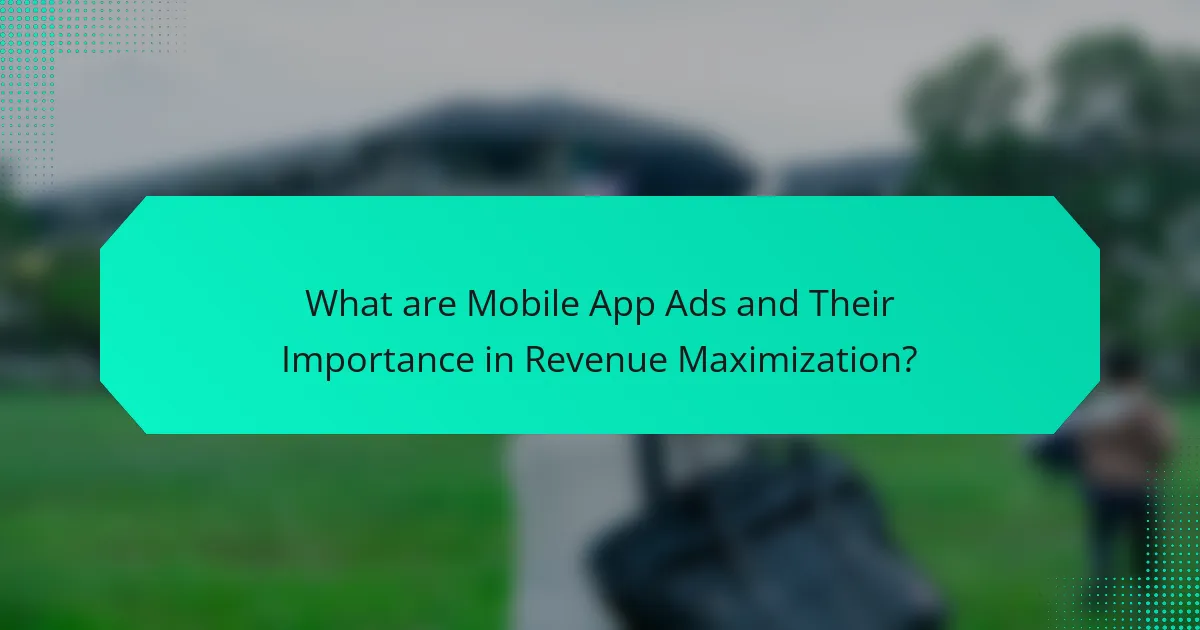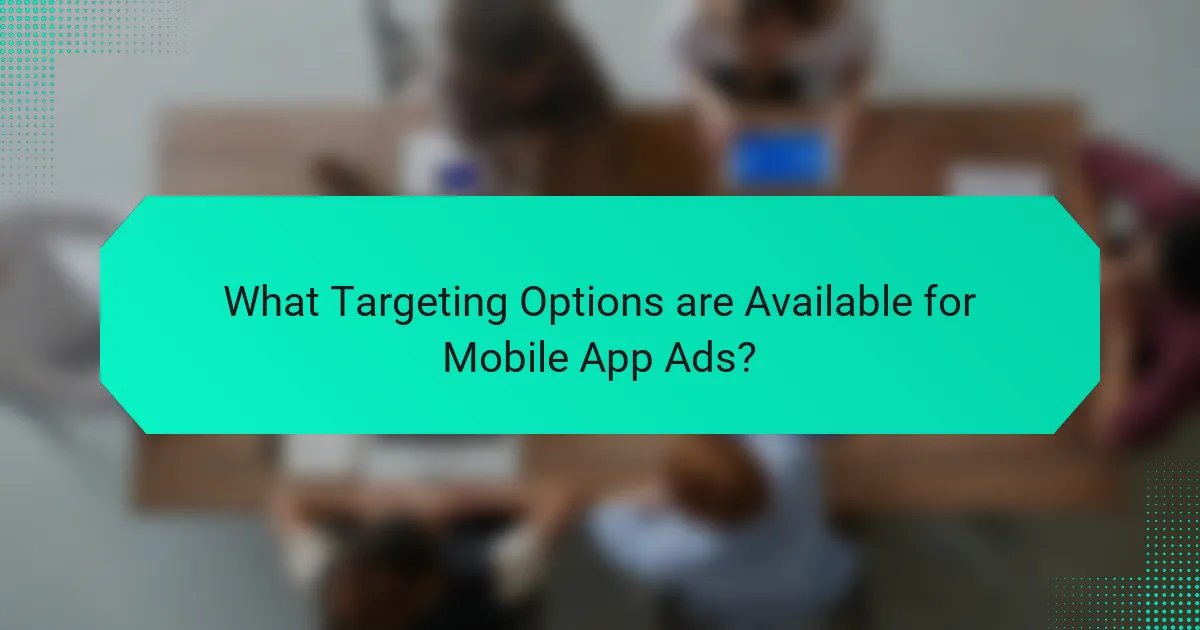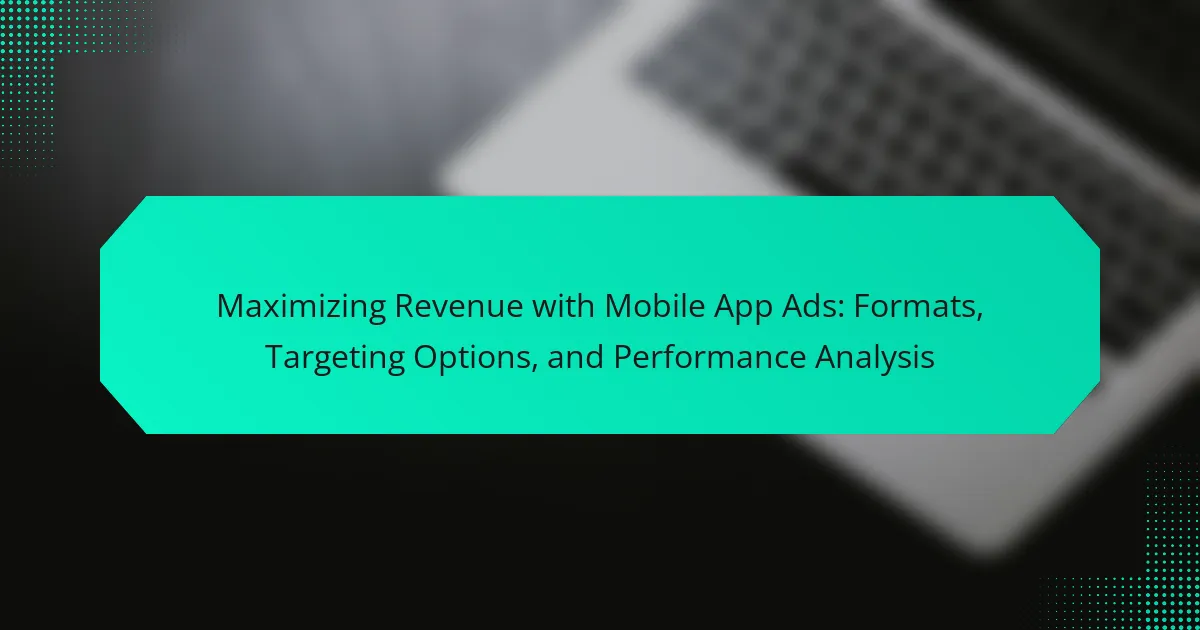Mobile app ads are promotional messages displayed within mobile applications, designed to generate revenue through user engagement. This article explores various formats of mobile app ads, including banner ads, interstitials, native ads, video ads, and rewarded ads, each serving distinct advertising strategies. It also examines targeting options such as demographic, behavioral, contextual, interest-based, retargeting, device, and lookalike targeting, which enhance ad relevance and engagement. Additionally, the article highlights the significance of performance analysis in optimizing ad effectiveness and maximizing revenue potential, supported by data-driven insights and metrics.

What are Mobile App Ads and Their Importance in Revenue Maximization?
Mobile app ads are promotional messages displayed within mobile applications. They serve to monetize apps by generating revenue through user engagement. These ads can take various formats, including banners, interstitials, and native ads. Their importance in revenue maximization lies in their ability to reach targeted audiences effectively. According to eMarketer, mobile ad spending is projected to exceed $200 billion by 2023. This growth indicates the increasing reliance on mobile ads for revenue generation. Additionally, well-implemented mobile ads can enhance user experience while driving conversions. Effective targeting strategies further boost ad performance and revenue potential.
How do Mobile App Ads function?
Mobile app ads function by displaying promotional content within mobile applications. Advertisers create ads that target specific user demographics and behaviors. These ads can appear as banners, interstitials, or native ads. When users interact with the app, the ad network serves relevant ads based on user data. This process involves real-time bidding where advertisers compete for ad space. The app developers earn revenue each time users click on or view these ads. According to Statista, mobile advertising spending is projected to reach $495 billion by 2024, highlighting the effectiveness of mobile app ads.
What are the key components of Mobile App Ads?
The key components of mobile app ads include ad formats, targeting options, and performance metrics. Ad formats encompass various types such as banners, interstitials, and native ads. Targeting options allow advertisers to reach specific demographics, behaviors, and interests. Performance metrics provide insights into impressions, clicks, and conversions. These components work together to optimize ad effectiveness and revenue generation. Research indicates that effective targeting can increase ad engagement by up to 50%.
How do these components influence ad effectiveness?
Ad effectiveness is influenced by components such as ad format, targeting options, and performance metrics. Different ad formats, like banners or interstitials, can engage users differently. For example, interstitial ads often yield higher engagement rates due to their full-screen nature. Targeting options allow advertisers to reach specific demographics, enhancing relevance and user interest. Performance metrics, such as click-through rates and conversion rates, provide data to optimize future campaigns. Studies show that tailored ads can increase user engagement by up to 50%. Thus, the combination of these components directly impacts the success of mobile app advertising efforts.
Why should businesses invest in Mobile App Ads?
Businesses should invest in Mobile App Ads to enhance visibility and drive user engagement. Mobile app advertising allows targeted reach to specific audiences. According to eMarketer, mobile ad spending is expected to surpass $400 billion by 2023. This growth indicates a significant shift in advertising strategies towards mobile platforms. Furthermore, mobile ads can increase conversion rates by 30% compared to traditional advertising methods. Businesses can leverage various ad formats, such as banners and interstitials, to capture user attention effectively. Investing in mobile app ads also provides valuable data analytics for performance tracking and optimization.
What are the potential revenue benefits of Mobile App Ads?
Mobile app ads can significantly enhance revenue for app developers and businesses. They provide a direct monetization channel through various ad formats, such as banners, interstitials, and rewarded videos. According to eMarketer, mobile ad spending is projected to reach $400 billion by 2024, highlighting the growing importance of mobile ads in revenue generation. In-app advertisements can also lead to increased user engagement, which can boost overall app usage and retention. Additionally, targeted advertising allows for personalized user experiences, resulting in higher click-through rates and conversions. This targeted approach can improve return on investment (ROI) for advertisers. Overall, mobile app ads present a lucrative opportunity for revenue growth through diverse formats and effective targeting strategies.
How do Mobile App Ads enhance user engagement?
Mobile app ads enhance user engagement by providing targeted content that aligns with user interests. These ads utilize data analytics to deliver personalized experiences. Personalization increases the likelihood of user interaction. Engaging ad formats, such as video and interactive ads, capture user attention effectively. According to a study by eMarketer, mobile video ads can increase user engagement rates by up to 20%. Moreover, timely and relevant ads can prompt users to take action, such as downloading an app or making a purchase. This direct call-to-action fosters a more immersive user experience. Overall, mobile app ads create a dynamic environment that keeps users engaged and encourages frequent app usage.

What are the Different Formats of Mobile App Ads?
The different formats of mobile app ads include banner ads, interstitial ads, native ads, video ads, and rewarded ads. Banner ads are rectangular advertisements displayed at the top or bottom of the app screen. Interstitial ads are full-screen ads that appear at transition points in an app. Native ads blend seamlessly with the app’s content, making them less intrusive. Video ads are short video clips that can be displayed before, during, or after app content. Rewarded ads incentivize users with in-app rewards for watching an ad. Each format serves distinct advertising strategies and user engagement levels.
What are the most common ad formats available for mobile apps?
The most common ad formats available for mobile apps include banner ads, interstitial ads, rewarded video ads, native ads, and in-app purchase ads. Banner ads are small, rectangular ads displayed at the top or bottom of the screen. Interstitial ads are full-screen ads that appear at natural transition points in the app. Rewarded video ads offer users in-app rewards for watching video advertisements. Native ads blend seamlessly with the app’s content, providing a less intrusive experience. In-app purchase ads promote additional content or features within the app. These formats are widely used due to their effectiveness in engaging users and generating revenue.
How do banner ads differ from interstitial ads?
Banner ads are small, rectangular advertisements displayed on the edges of a mobile app screen. They remain visible while users interact with the app. In contrast, interstitial ads are full-screen advertisements that cover the entire app interface. These ads appear at natural transition points, such as between activities or during loading screens.
Banner ads typically have lower engagement rates compared to interstitial ads. Interstitial ads can capture user attention more effectively due to their size and placement. Studies show that interstitial ads often lead to higher click-through rates because they interrupt the user experience in a controlled manner.
Additionally, banner ads are generally less intrusive, allowing users to continue their activity without significant interruption. Interstitial ads, while effective, can lead to user frustration if overused. This distinction is crucial for app developers aiming to maximize revenue through ad formats.
What are the advantages of video ads in mobile applications?
Video ads in mobile applications offer several advantages. They enhance user engagement compared to static ads. Users are more likely to interact with video content. This interaction can lead to higher conversion rates. Video ads can convey more information in a short time. They utilize visual and auditory elements to capture attention. Studies show that video ads have a higher retention rate. For instance, a study by Wyzowl found that 84% of consumers were convinced to buy a product after watching a brand’s video. Additionally, video ads can be targeted effectively, reaching specific demographics. This targeting improves ad relevance and effectiveness. Overall, video ads can significantly boost revenue for mobile applications.
Which ad formats are most effective for specific app types?
Banner ads are most effective for social media apps. These ads blend seamlessly into the user experience. They can be easily dismissed if not engaging. Video ads work well for gaming apps. They capture user attention and demonstrate gameplay. Interstitial ads are effective for utility apps. These full-screen ads appear at natural transition points. Native ads suit content-driven apps, like news or blogs. They provide a non-disruptive experience. According to a study by eMarketer, video ads have a higher engagement rate, especially in gaming. In contrast, banner ads yield better results in social media contexts.
What role does user experience play in ad format selection?
User experience significantly influences ad format selection. A positive user experience enhances engagement with ads. When ads are well-integrated into the app, users are less likely to feel disrupted. Formats that prioritize user experience, such as native ads, often yield higher click-through rates. Research shows that 70% of users prefer native ads over traditional formats. This preference leads to better performance metrics for advertisers. Therefore, selecting ad formats that align with user experience is crucial for maximizing revenue.
How can brands test different ad formats for optimal results?
Brands can test different ad formats for optimal results by employing A/B testing methods. A/B testing involves creating two or more variations of an ad format. Each variation is shown to a different segment of the target audience. This approach allows brands to compare performance metrics such as click-through rates and conversion rates.
Using analytics tools, brands can track user engagement with each ad format. This data provides insights into which format resonates best with the audience. Studies show that A/B testing can improve ad performance by up to 30%. Brands can also iterate based on feedback and performance data to refine their ad strategies.

What Targeting Options are Available for Mobile App Ads?
Mobile app ads offer several targeting options to reach specific audiences effectively. These options include demographic targeting, which allows advertisers to reach users based on age, gender, and location. Behavioral targeting focuses on users’ past interactions and app usage patterns. Contextual targeting displays ads based on the content of the app in use.
Interest-based targeting leverages user interests derived from their online behavior. Retargeting options enable advertisers to reach users who have previously interacted with their app or website. Device targeting allows ads to be shown based on the type of device or operating system. Lastly, lookalike targeting identifies new users who resemble existing customers.
These targeting options enhance ad relevance and increase the likelihood of user engagement.
How do demographic targeting options impact ad performance?
Demographic targeting options significantly enhance ad performance by ensuring ads reach the most relevant audiences. By tailoring ads based on age, gender, income, and interests, advertisers can increase engagement rates. Research indicates that targeted ads lead to a 50% higher click-through rate compared to non-targeted ads. This specificity reduces wasted ad spend and improves conversion rates. For instance, ads aimed at millennials often perform better on platforms popular with that demographic. Additionally, demographic insights allow for better messaging that resonates with the audience. Overall, effective demographic targeting is crucial for maximizing the effectiveness of ad campaigns.
What are the key demographics to consider for mobile ads?
Key demographics to consider for mobile ads include age, gender, location, income, and device usage. Age influences preferences and engagement levels. For example, younger audiences may respond better to social media ads. Gender can affect product interests and advertising appeal. Location helps target users based on regional trends and behaviors. Income levels determine purchasing power and ad relevance. Device usage indicates which platforms and formats are most effective. According to Statista, mobile ad spending is projected to reach $400 billion by 2024, highlighting the importance of targeting the right demographics.
How can businesses utilize behavioral targeting?
Businesses can utilize behavioral targeting by analyzing user data to tailor advertisements. This approach allows businesses to reach potential customers based on their online behaviors and preferences. By tracking actions such as website visits, clicks, and purchase history, businesses can create personalized ad experiences. For instance, a retail app can show products similar to what a user previously viewed. According to a study by eMarketer, targeted ads can increase conversion rates by up to 50%. This demonstrates the effectiveness of behavioral targeting in enhancing user engagement and driving sales.
What role does location targeting play in mobile advertising?
Location targeting in mobile advertising allows advertisers to deliver ads based on a user’s geographic location. This strategy enhances ad relevance and effectiveness. For instance, a study by eMarketer found that 70% of consumers prefer ads that reflect their local context. Additionally, location targeting can increase engagement rates by providing timely offers to users near a store. This leads to higher conversion rates, as users are more likely to respond to ads relevant to their immediate surroundings. Overall, location targeting is crucial for maximizing the impact of mobile advertising campaigns.
How can geofencing enhance ad relevance?
Geofencing enhances ad relevance by targeting users based on their real-time location. This technology allows advertisers to deliver tailored ads when users enter specific geographic areas. For instance, a retail store can send promotions to users when they are nearby. This increases the likelihood of engagement, as the ads are contextually relevant. Research indicates that location-based ads can improve click-through rates by up to 50%. By utilizing geofencing, businesses can create personalized experiences that resonate with users, driving higher conversion rates.
What are the benefits of using location-based ads?
Location-based ads provide targeted marketing that increases engagement and conversion rates. By utilizing geographic data, businesses can reach potential customers in specific locations. This relevance enhances user experience and drives foot traffic to physical stores. Studies show that location-based ads can improve click-through rates by 20% compared to non-targeted ads. Furthermore, these ads allow for personalized messaging based on local events or promotions. This tailored approach fosters customer loyalty and brand recognition. Overall, location-based advertising effectively connects businesses with their audience at the right time and place.

How can Performance Analysis Improve Mobile App Ad Strategies?
Performance analysis can significantly enhance mobile app ad strategies by providing data-driven insights. It allows marketers to assess the effectiveness of various ad formats and targeting options. By analyzing metrics such as click-through rates and conversion rates, businesses can identify which ads yield the highest engagement. This data helps optimize ad placements and refine audience targeting. For instance, a study by Statista found that targeted ads can increase conversion rates by up to 50%. Furthermore, performance analysis enables A/B testing to compare different ad variations. This iterative process leads to continuous improvement in ad effectiveness. Overall, leveraging performance analysis leads to more informed decisions, maximizing revenue potential from mobile app ads.
What metrics should be tracked for mobile ad performance?
Key metrics for mobile ad performance include click-through rate (CTR), conversion rate, cost per click (CPC), and return on ad spend (ROAS). CTR measures the percentage of users who click on an ad after seeing it. A higher CTR indicates effective ad engagement. Conversion rate tracks the percentage of users who complete a desired action after clicking the ad. This metric is crucial for assessing ad effectiveness. CPC indicates how much is spent for each click on the ad. Lower CPC values suggest more efficient ad spending. ROAS calculates the revenue generated for every dollar spent on advertising. A higher ROAS signifies better ad profitability. Other important metrics include impressions, reach, and engagement rate, as they provide insights into ad visibility and user interaction. Tracking these metrics helps optimize mobile ad strategies and maximize revenue.
How do click-through rates influence ad effectiveness?
Click-through rates (CTR) directly influence ad effectiveness by measuring user engagement with ads. A higher CTR indicates that more users are clicking on the ad, suggesting that the ad is relevant and appealing. This relevance often leads to higher conversion rates, as interested users are more likely to complete desired actions. According to a study by WordStream, the average CTR for Google Ads across all industries is 3.17% for search ads and 0.46% for display ads. Ads with higher CTRs typically receive better placements and lower costs per click, enhancing overall advertising performance. Therefore, optimizing for higher CTR is essential for maximizing the effectiveness of mobile app ads.
What is the importance of conversion tracking?
Conversion tracking is crucial for measuring the effectiveness of marketing campaigns. It allows businesses to analyze user actions and determine which ads lead to desired outcomes. By tracking conversions, companies can optimize their ad spend and improve return on investment (ROI). Studies show that businesses using conversion tracking can increase their revenue by up to 30%. Additionally, it helps identify successful strategies and areas needing improvement. Accurate conversion data informs future marketing decisions and enhances targeting strategies. Overall, conversion tracking is essential for maximizing revenue through informed advertising efforts.
How can A/B testing be utilized in performance analysis?
A/B testing can be utilized in performance analysis to compare two versions of an app or ad to determine which performs better. This method involves splitting the audience into two groups. Each group is exposed to a different version of the app or ad. Performance metrics such as click-through rates, conversion rates, and user engagement are then measured.
The results provide insights into user preferences and behaviors. For instance, a study by Google found that A/B testing can increase conversion rates by as much as 300%. By analyzing the data, marketers can make informed decisions to optimize their ads. This leads to improved revenue generation and better user experiences.
What are the steps to effectively conduct A/B testing?
Define the main entity of A/B testing. A/B testing is a method used to compare two versions of a variable to determine which performs better. Identify the objective of the test. Clearly define what you want to test, such as an ad format or call-to-action. Select the target audience. Ensure that the audience is representative of your overall user base. Create two variations. Develop version A and version B, ensuring only one variable differs between them. Implement the test. Use a reliable A/B testing tool to randomly assign users to each version. Monitor performance metrics. Track key performance indicators such as click-through rates and conversion rates. Analyze results. Use statistical analysis to determine if one version significantly outperforms the other. Make data-driven decisions. Use the insights gained to optimize your mobile app ads for better revenue generation.
How can insights from A/B testing inform future ad strategies?
Insights from A/B testing can significantly inform future ad strategies by providing data-driven evidence on what works best. A/B testing allows marketers to compare different ad variations to identify which performs better. This process highlights user preferences and behaviors. For example, a study by Optimizely found that A/B testing can lead to conversion rate improvements of up to 49%. Marketers can use these insights to optimize ad creatives, targeting, and placements. By analyzing metrics like click-through rates and conversion rates, businesses can make informed decisions. Ultimately, A/B testing helps refine advertising strategies for better ROI.
What best practices should be followed for maximizing revenue with mobile app ads?
To maximize revenue with mobile app ads, implement targeted advertising strategies. Focus on user segmentation based on behavior and preferences. Utilize A/B testing to optimize ad placements and formats. Choose high-performing ad networks that fit your app’s audience. Monitor analytics to track ad performance and adjust strategies accordingly. Incorporate various ad formats, such as banners, interstitials, and rewarded videos, to enhance user engagement. Ensure ads are relevant and non-intrusive to maintain a positive user experience. Regularly update your ad inventory to prevent ad fatigue.
Mobile app ads are promotional messages within applications that generate revenue through user engagement. This article explores the various formats of mobile app ads, including banners, interstitials, and video ads, and their significance in maximizing revenue. It also delves into targeting options such as demographic and behavioral targeting, and highlights the importance of performance analysis in optimizing ad strategies. Key metrics for measuring ad effectiveness and best practices for enhancing user engagement and revenue generation are also discussed.


